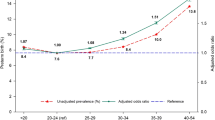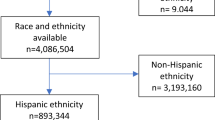Abstract
Objective
Studies of perinatal health outcomes in Canadian First Nations populations have largely focused on limited geographical areas and have been unable to examine outcomes by registered status and community residence. In this study, we compare rates of adverse birth outcomes among First Nations individuals living within vs. outside of First Nations communities and those with vs. without registered status.
Methods
Data included 13,506 singleton pregnancies from the 2006 Canadian Birth-Census Cohort. Outcomes examined included preterm birth (PTB), small- and large-for-gestational-age birth (SGA, LGA), stillbirth, overall infant mortality, and neonatal and postneonatal mortality. Risk ratios (RRs) were estimated with adjustment for maternal age, education, parity, and paternal education.
Results
Mothers living in First Nations communities and those with status had elevated adjusted risks of LGA (RR for First Nations community residence = 1.22, 95% CI = 1.09–1.35; RR for status = 1.50, 95% CI = 1.16–1.93). Rates of SGA were significantly lower among mothers with status (adjusted RR = 0.62, 95% CI = 0.44–0.86). Rates of PTB did not vary substantially by residence or by status. Adjusted differences in fatal outcomes could not be estimated, owing to small cell sizes. However, mothers living in First Nations communities had higher crude rates of infant mortality (10.9 vs. 7.7 per 1000), particularly for neonatal mortality (6.1 vs. 2.9).
Conclusion
Future investigations should explore risk factors, including food security and access to health care services, that may explain disparities in SGA and LGA by status and residence within First Nations populations.
Résumé
Objectif
Les études examinant les issues de santé périnatale des populations canadiennes des Premières Nations examinent, pour la plupart d’entre elles, des étendues géographiques limitées. De plus, ces études n’ont pas pu examiner les issues de santé périnatale selon la statut (statut d’Indien inscrit), ni selon la résidence dans les communautés des Premières Nations. Dans cette étude, notre objectif est d’examiner la prévalence des diverses issues néonatales selon la résidence dans une communauté des Premières Nations ainsi que selon le statut.
Méthodes
13 506 grossesses simples de la cohorte canadienne de naissance du Recensement de 2006 ont été examinées. Les complications néonatales étudiées comprenaient la naissance prématurée, le nouveau-né avec un petit ou un grand poids pour l’âge gestationnel (PAG, GAG), la mortinaissance, la mortalité infantile totale ainsi que la mortalité néonatale et post-néonatale. Les données ont été examinées selon la résidence dans une communauté des Premières Nations ou non et selon l’obtention ou non de statut. Les risques relatifs (RR) ont été estimés avec l’ajustement pour l’âge maternel, le niveau de scolarité de la mère, la parité et le niveau de scolarité du père.
Résultats
Les mères habitant dans une communauté des Premières Nations ainsi que celles qui avaient de statut avaient un risque ajusté élevé de nouveau-né GAG (RR pour la résidence dans une communauté des Premières Nations = 1,22, IC de 95 % : 1,09, 1,35; RR pour le statut = 1,50, IC de 95 % : 1,16, 1,93). La prévalence de nouveau-nés PAG était significativement plus basse chez les mères ayant du statut (RR ajusté = 0,62, IC de 95 % : 0,44, 0,86) comparativement à celles n’ayant pas de statut. La prévalence des naissances prématurées n’a pas significativement varié selon la résidence, ni selon le statut. Les différences ajustées pour les issues fatales n’ont pas pu être estimées en raison de la taille de l’échantillon. Cependant, les mères qui habitaient dans une communauté des Premières Nations avaient un taux brut de mortalité infantile plus élevé (10,9 par 1 000, c. 7,7 par 1000), particulièrement pour la mortalité néonatale (6,1 c. 2,9), comparativement à celles n’habitant pas dans une communauté des Premières Nations.
Conclusion
De futures études sont nécessaires afin d’examiner les facteurs, tel que la sécurité alimentaire et l’accès aux services de santé, pouvant expliquer les différences de prévalence de nouveau-nés PAG et GAG selon le statut et la résidence au sein des populations des Premières Nations.
Similar content being viewed by others
References
Black, T. L., Raine, K., & Willows, N. D. (2008). Understanding prenatal weight gain in First Nations women. Canadian Journal of Diabetes, 32, 198–205.
Bushnik, T., Yang, S., Kramer, M., Kaufman, J., Sheppard, A., & Wilkins, R. (2016). The 2006 Canadian Birth-Census Cohort. Health Reports, 27, 11–19.
Canadian Institute of Child Health. (2000). Aboriginal Children & Youth. The Health of Canada’s Children: A CICH Profile. 3rd Edition ed:143–76.
Chen, L., Xiao, L., Auger, N., Torrie, J., McHugh, N. G., Zoungrana, H., et al. (2015). Disparities and trends in birth outcomes, perinatal and infant mortality in Aboriginal vs. non-Aboriginal populations: a population-based study in Quebec, Canada 1996-2010. PLoS One, 10, e0138562.
Dwyer, J., Boulton, A., Lavoie, J. G., Tenbensel, T., & Cumming, J. (2014). Indigenous peoples’ health care: new approaches to contracting and accountability at the public administration frontier. Public Management Review, 16, 1091–1112.
He, H., Xiao, L., Torrie, J. E., Auger, N., McHugh, N. G., Zoungrana, H., et al. (2017). Disparities in infant hospitalizations in Indigenous and non-Indigenous populations in Quebec, Canada. CMAJ, 189, E739–EE46.
Health Canada. (2011). A statistical profile on the health of First Nations in Canada: vital statistics for Atlantic and Western Canada, 2001/2002. Ottawa.
Health Council of Canada. (2005). The health status of Canada’s First Nations, Métis and Inuit peoples.
Hutcheon, J. A., Zhang, X., Cnattingius, S., Kramer, M. S., & Platt, R. W. (2008). Customised birthweight percentiles: does adjusting for maternal characteristics matter? BJOG, 115, 1397–1404.
Hutcheon, J. A., Walker, M., & Platt, R. W. (2011). Assessing the value of customized birth weight percentiles. American Journal of Epidemiology, 173, 459–467.
Kaspar, V. (2014). The lifetime effect of residential school attendance on indigenous health status. American Journal of Public Health, 104, 2184–2190.
Kramer, M. S., Platt, R. W., Wen, S. W., Joseph, K. S., Allen, A., Abrahamowicz, M., et al. (2001). A new and improved population-based Canadian reference for birth weight for gestational age. Pediatrics, 108, E35.
Lavoie, J. G. (2013). Policy silences: why Canada needs a National First Nations, Inuit and Metis health policy. International Journal of Circumpolar Health, 72, 22690.
Lavoie, J., Boulton, A., & Dwyer, J. (2010). Analysing contractual environments: lessons from Indigenous health in Canada, Australia and New Zealand. Public Administration, 88, 665–679.
Lemchuk-Favel, L., & Jock, R. (2004). Aboriginal health systems in Canada: nine case studies. Journal of Aboriginal Health, 1, 28–51.
Luo, Z. C., Wilkins, R., Heaman, M., Martens, P., Smylie, J., Hart, L., et al. (2010). Birth outcomes and infant mortality by the degree of rural isolation among First Nations and non-First Nations in Manitoba, Canada. The Journal of Rural Health, 26, 175–181.
MacMillan, H. L., MacMillan, A. B., Offord, D. R., & Dingle, J. L. (1996). Aboriginal health. CMAJ, 155, 1569–1578.
Mashford-Pringle, A. R. (2013). Self-determination in health care: a multiple case study of four First Nations communities in Canada. Toronto: Dalla Lana School of Public Health, University of Toronto.
National Collaborating Centre for Aboriginal Health. (2013). An Overview of Aboriginal Health in Canada. Prince George, BC.
Newhouse, D., & Peters, E. (2003). Not strangers in these parts: urban Aboriginal peoples. Ottawa: Policy Research Initiative.
Reading, J. (2009). The crisis of chronic disease among Aboriginal peoples: a challenge for public health, population health and social policy. Victoria, BC: Centre for Aboriginal Health Research, University of Victoria.
Reading, C. L., & Wein, F. (2013). Health inequalities and the social determinants of Aboriginal peoples’ health. Prince George, BC: National Collaborating Centre for Aboriginal Health.
Sheppard, A. J., Shapiro, G. D., Bushnik, T., Wilkins, R., Perry, S., Kaufman, J. S., et al. (2017). Birth outcomes among First Nations, Métis and Inuit populations. Health Reports, 28, 11–16.
Simonet, F., Wilkins, R., & Luo, Z. C. (2012). Temporal trends in Inuit, First Nations and non-Aboriginal birth outcomes in rural and northern Quebec. International Journal of Circumpolar Health, 71.
Smith, D. (2002). Comprehensive maternal child health care in First Nations and Inuit communities. Ottawa: Office of Nursing Services, First Nations and Inuit Health Branch, Health Canada.
Smylie, J., & Adomako, P. (2009). Indigenous children’s health report: health assessment in action. Toronto: The Centre for Research on Inner City Health, St. Michael’s Hospital.
Smylie, J., & Anderson, M. (2006). Understanding the health of indigenous peoples in Canada: key methodological and conceptual challenges. CMAJ, 175, 602.
Smylie J, Crengle S, Freemantle J, Taualii M. (2010). Indigenous birth outcomes in Australia, Canada, New Zealand and the United States - an overview. Open Womens Health Journal:7–17.
Statistics Canada. (2006a). Aboriginal Peoples in Canada in 2006: First Nations People, Métis and Inuit, 2006 Census. Catalogue no. 97-558-XIE.
Statistics Canada. (2006b). Census Technical Report: Coverage. Catalogue no. 92-567-X. Ottawa, ON 2010.
Statistics Canada. (2006c). Census population net undercoverage ‘on reserve’, for Canada, Region. 2009. Accessed 24 May, 2018.
Statistics Canada. (2011). Aboriginal Peoples in Canada: First Nations People, Métis and Inuit. Catalogue no. 99-011-X2011001. National Household Survey. Ottawa.
The First Nations Information Governance Centre. (2012). First Nations Regional Health Survey (RHS) Phase 2 (2008/10) National Report on Adults. Ottawa: Youth and Children Living in First Nations Communities.
Tookenay, V. F. (1996). Improving the health status of aboriginal people in Canada: new directions, new responsibilities. CMAJ, 155, 1581–1583.
Young, T. K. (2003). Review of research on aboriginal populations in Canada: relevance to their health needs. BMJ, 327, 419–422.
Author information
Authors and Affiliations
Corresponding author
Electronic supplementary material
ESM 1
(DOCX 32.2 kb)
Rights and permissions
About this article
Cite this article
Shapiro, G.D., Sheppard, A.J., Bushnik, T. et al. Adverse birth outcomes and infant mortality according to registered First Nations status and First Nations community residence across Canada. Can J Public Health 109, 692–699 (2018). https://doi.org/10.17269/s41997-018-0134-6
Received:
Accepted:
Published:
Issue Date:
DOI: https://doi.org/10.17269/s41997-018-0134-6




